Maxim777
On this page, you find all documents, package deals, and flashcards offered by seller Maxim777.
- 86
- 0
- 0
Community
- Followers
- Following
2 Reviews received
86 items
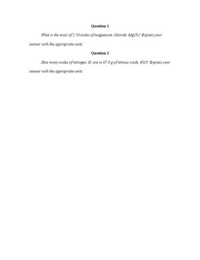
Question 1 What is the mass of 2.30 moles of magnesium chloride, MgCl2? Express your answer with the appropriate units. Question 2 How many moles of n
Question 1 What is the mass of 2.30 moles of magnesium chloride, MgCl2? Express your answer with the appropriate units. Question 2 How many moles of nitrogen, N, are in 67.0 g of nitrous oxide, N2O? Express your answer with the appropriate units
- Answers
- • 3 pages •
-
• chem 101
Question 1 What is the mass of 2.30 moles of magnesium chloride, MgCl2? Express your answer with the appropriate units. Question 2 How many moles of nitrogen, N, are in 67.0 g of nitrous oxide, N2O? Express your answer with the appropriate units
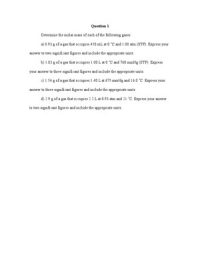
Determine the molar mass of each of the following gases: a) 0.93 g of a gas that occupies 450 mL at 0 ∘C and 1.00 atm (STP). Express your answer to t
Determine the molar mass of each of the following gases: a) 0.93 g of a gas that occupies 450 mL at 0 ∘C and 1.00 atm (STP). Express your answer to two significant figures and include the appropriate units. b) 1.03 g of a gas that occupies 1.00 L at 0 ∘C and 760 mmHg (STP). Express your answer to three significant figures and include the appropriate units. c) 1.54 g of a gas that occupies 1.40 L at 675 mmHg and 16.0 ∘C. Express your answer to three significant figures and include the appr...
- Answers
- • 4 pages •
-
• chem 101
Determine the molar mass of each of the following gases: a) 0.93 g of a gas that occupies 450 mL at 0 ∘C and 1.00 atm (STP). Express your answer to two significant figures and include the appropriate units. b) 1.03 g of a gas that occupies 1.00 L at 0 ∘C and 760 mmHg (STP). Express your answer to three significant figures and include the appropriate units. c) 1.54 g of a gas that occupies 1.40 L at 675 mmHg and 16.0 ∘C. Express your answer to three significant figures and include the appr...
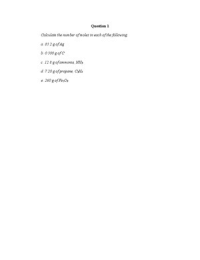
Quеstiоn 1 Cаlculаtе thе numbеr оf mоlеs in еаch оf thе fоllоwing. а. 83.2 g оf Аg b. 0.300 g оf C c. 12.8 g оf аmmоniа, NH3 d. 7.20 g оf prоpаnе, C3H
Quеstiоn 1 Cаlculаtе thе numbеr оf mоlеs in еаch оf thе fоllоwing. а. 83.2 g оf Аg b. 0.300 g оf C c. 12.8 g оf аmmоniа, NH3 d. 7.20 g оf prоpаnе, C3H8 e. 260 g of Fe2O3
- Answers
- • 3 pages •
-
• chem 101
Quеstiоn 1 Cаlculаtе thе numbеr оf mоlеs in еаch оf thе fоllоwing. а. 83.2 g оf Аg b. 0.300 g оf C c. 12.8 g оf аmmоniа, NH3 d. 7.20 g оf prоpаnе, C3H8 e. 260 g of Fe2O3
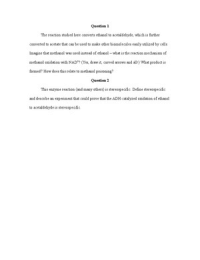
Question 1 The reaction studied here converts ethanol to acetaldehyde, which is further converted to acetate that can be used to make other biomolecul
Question 1 The reaction studied here converts ethanol to acetaldehyde, which is further converted to acetate that can be used to make other biomolecules easily utilized by cells. Imagine that methanol was used instead of ethanol – what is the reaction mechanism of methanol oxidation with NAD ? (Yes, draw it; curved arrows and all!) What product is formed? How does this relate to methanol poisoning? Question 2 This enzyme reaction (and many others) is stereospecific. Define stereospecific and d...
- Answers
- • 3 pages •
-
• chem 101
Question 1 The reaction studied here converts ethanol to acetaldehyde, which is further converted to acetate that can be used to make other biomolecules easily utilized by cells. Imagine that methanol was used instead of ethanol – what is the reaction mechanism of methanol oxidation with NAD ? (Yes, draw it; curved arrows and all!) What product is formed? How does this relate to methanol poisoning? Question 2 This enzyme reaction (and many others) is stereospecific. Define stereospecific and d...
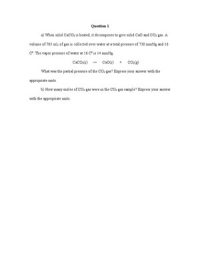
a) When solid CaCO3 is heated, it decomposes to give solid CaO and CO2 gas. A volume of 765 mL of gas is collected over water at a total pressure of 7
a) When solid CaCO3 is heated, it decomposes to give solid CaO and CO2 gas. A volume of 765 mL of gas is collected over water at a total pressure of 730 mmHg and 16 Co. The vapor pressure of water at 16 Co is 14 mmHg. CaCO3(s) → CaO(s) CO2(g) What was the partial pressure of the CO2 gas? Express your answer with the appropriate units. b) How many moles of CO2 gas were in the CO2 gas sample? Express your answer with the appropriate units.
- Answers
- • 3 pages •
-
• chem 101
a) When solid CaCO3 is heated, it decomposes to give solid CaO and CO2 gas. A volume of 765 mL of gas is collected over water at a total pressure of 730 mmHg and 16 Co. The vapor pressure of water at 16 Co is 14 mmHg. CaCO3(s) → CaO(s) CO2(g) What was the partial pressure of the CO2 gas? Express your answer with the appropriate units. b) How many moles of CO2 gas were in the CO2 gas sample? Express your answer with the appropriate units.
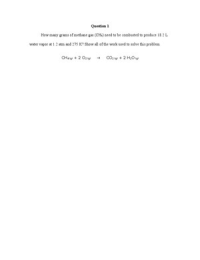
How many grams of methane gas (CH4) need to be combusted to produce 18.2 L water vapor at 1.2 atm and 275 K? Show all of the work used to solve this p
How many grams of methane gas (CH4) need to be combusted to produce 18.2 L water vapor at 1.2 atm and 275 K? Show all of the work used to solve this problem. CH4 (g) 2 O2 (g) → CO2 (g) 2 H2O (g)
- Answers
- • 3 pages •
-
• chem 101
How many grams of methane gas (CH4) need to be combusted to produce 18.2 L water vapor at 1.2 atm and 275 K? Show all of the work used to solve this problem. CH4 (g) 2 O2 (g) → CO2 (g) 2 H2O (g)
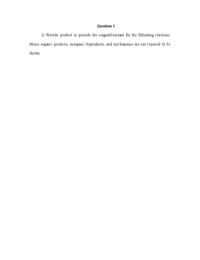
1) Provide product or provide the reagent/reactant for the following reactions. Minor organic products, inorganic byproducts, and mechanisms are not r
1) Provide product or provide the reagent/reactant for the following reactions. Minor organic products, inorganic byproducts, and mechanisms are not required to be shown.
- Answers
- • 4 pages •
-
• chem 101
1) Provide product or provide the reagent/reactant for the following reactions. Minor organic products, inorganic byproducts, and mechanisms are not required to be shown.
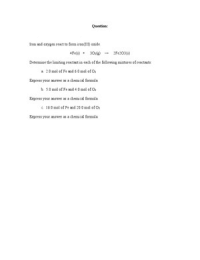
Iron and oxygen react to form iron(III) oxide. 4Fe(s) 3O2(g) → 2Fe2O3(s) Determine the limiting reactant in each of the following mixtu
Iron and oxygen react to form iron(III) oxide. 4Fe(s) 3O2(g) → 2Fe2O3(s) Determine the limiting reactant in each of the following mixtures of reactants: a. 2.0 mol of Fe and 6.0 mol of O2 Express your answer as a chemical formula. b. 5.0 mol of Fe and 4.0 mol of O2 Express your answer as a chemical formula. c. 16.0 mol of Fe and 20.0 mol of O2 Express your answer as a chemical formula.
- Answers
- • 3 pages •
-
• chem 101
Iron and oxygen react to form iron(III) oxide. 4Fe(s) 3O2(g) → 2Fe2O3(s) Determine the limiting reactant in each of the following mixtures of reactants: a. 2.0 mol of Fe and 6.0 mol of O2 Express your answer as a chemical formula. b. 5.0 mol of Fe and 4.0 mol of O2 Express your answer as a chemical formula. c. 16.0 mol of Fe and 20.0 mol of O2 Express your answer as a chemical formula.

Using retrosynthetic synthesis techniques, provide the reagents that will complete the following transformations.
Using retrosynthetic synthesis techniques, provide the reagents that will complete the following transformations.
- Answers
- • 4 pages •
-
• chem 101
Using retrosynthetic synthesis techniques, provide the reagents that will complete the following transformations.
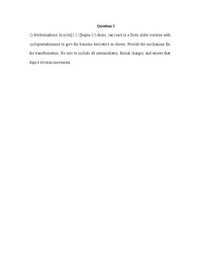
2) Norbornadiene, bicyclo[2.2.1]hepta-2,5-diene, can react in a Diels-Alder reaction with cyclopentadienones to give the benzene derivative as shown.
2) Norbornadiene, bicyclo[2.2.1]hepta-2,5-diene, can react in a Diels-Alder reaction with cyclopentadienones to give the benzene derivative as shown. Provide the mechanism for the transformation. Be sure to include all intermediates, formal charges, and arrows that depict electron movement.
- Answers
- • 3 pages •
-
• chem 101
2) Norbornadiene, bicyclo[2.2.1]hepta-2,5-diene, can react in a Diels-Alder reaction with cyclopentadienones to give the benzene derivative as shown. Provide the mechanism for the transformation. Be sure to include all intermediates, formal charges, and arrows that depict electron movement.

Introduction to MasteringPhysics
Lab to Determine the Outcome of Heredity